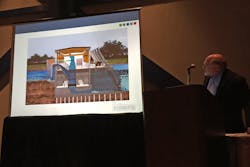We’re coming up on the 10th anniversary this year of the devastating Hurricane Katrina, which hit the U.S. Gulf Coast in August 2005. It’s the costliest natural disaster in U.S. history, costing almost $125 billion and more than 1,800 lives. Most of that devastation was in New Orleans, where levee failures caused some 80 percent of the city to be flooded.
Since then, the U.S. Army Corps of Engineers has been working on a flood control system to keep that from happening again. The New Orleans Permanent Canal Closures and Pumps (PCCP) project, designed to handle the next 100-year storm (one that has a 1 percent likelihood of happening in any given year), will manage water levels on three canals in New Orleans through 17 massive pumps from Patterson Pump Co., driven by innovative vertical gearmotors from Baldor Electric.
The Corps of Engineers put a temporary pumping system into place in 2006, then awarded the $615 million permanent project in late 2012. The PCCP project puts pump stations at the mouth of the 17th Street, Orleans Avenue and London Avenue canals. They will be able to pump 11 million gallons per minute (GPM) from the canals into nearby Lake Pontchartrain in the event of hurricane storm surges, keeping water from topping flood walls.
The 17 pumps from Patterson include 10 large and seven smaller pumps. “These are some monster pumps,” says Jack Claxton, vice president of engineering for Patterson, who described the circuitous trek necessary to get the huge pumps from where they’re made in Toccoa, Ga., to New Orleans. “It’s going to take 150 of the largest flatbed trucks to ship this equipment.”
Claxton detailed the pumping system during ABB’s Automation and Power World in Houston this week.
The large pumps are rated at 1,800 cfs (cubic feet per second), which translates to almost 1.2 GPM (gallons per minute). “An Olympic-size swimming pool holds 660,000 gallons,” Claxton says. “So with the 1.2 million GPM pump, you’ve got about 30 seconds to get out of that pool.” The small pumps have half the flow rate—“only” 900 cfs, or about 400,000 GPM, he adds.
“We’ve pushed all kinds of limits with this pump,” Claxton says. “We are at some major limits from a number of perspectives.”
The large pump has a 10x10 ft square discharge, which Claxton says is “a little bit unusual.” Though the discharge is usually round, the square design enables Patterson to transition to a rectangular flow pretty quickly to get the water pumping out.
There are no valves in the pumps, Claxton notes. They instead respond to the head (pressure) that is generated by the difference in the water elevations on the canal side (the suction side) and the lake side (the discharge side). “There are various circumstances that will cause the water levels to vary,” Claxton explains. “There was a full range of water levels that we had to engineer for.”
The pumps use gearmotors from Baldor Electric, which are themselves pretty innovative. Based on horizontal gearmotors typically supplied to the mining industry, Baldor decided it made sense to flip to a vertical design for pumping applications, according to Joe Ribovich, sales engineer for Baldor. Baldor took this idea to Patterson before the PCCP project even started, he says, so when PCCP came along the design really made sense.
Instead of a traditional high-horsepower, high-pole-count, single-speed induction motor or synchronous motor, Baldor’s design uses a relatively low-pole-count motor coupled to a single reduction planetary reducer. “It’s higher efficiency, requires less maintenance, and has a smaller footprint,” Ribovich says.
Each customized motor has a variable-frequency drive (VFD) attached to it. For the smaller motors, the VFD provides flow control that might be useful for the operation of the pump stations, Claxton says. On the larger units, the VFDs enable 10 starts per hour. This contrasts which a typical design, which has to cool down for four hour before it can be started again. “In hurricane conditions, you might have bands 30 minutes apart,” Ribovich notes. “Waiting four hours just wasn’t acceptable.”
Also, although they run off line power under normal conditions, in hurricane conditions, the motors will run off diesel power. The pump stations will have standalone power and enough diesel fuel to power generators for five days in the event of an emergency.
The PCCP project is scheduled for completion in 2017. The Orleans Avenue pump station will use three of the smaller pumps; the London Avenue station will have four large and two small pumps; and the 17th Street station will have six large and two small pumps. The first pump test should be a year or year and a half away, Claxton says, with the last pump text expected around spring 2017.
The delivery dates for motors are spread throughout 2016, from February to September, Ribovich says.
About the Author
Aaron Hand
Editor-in-Chief, ProFood World

Leaders relevant to this article:
